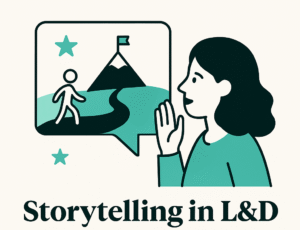There are a dizzying number of acronyms and terminology in the learning and development industry. It can be confusing to understand what differentiates each term and how that translates into finding the solution your organization needs.
In this blog, we’ll break down the key distinctions between LMS and LXP, explore the advantages of combining both platforms, and help you determine the best approach to support employee development and drive business success.
The answer lies in not just one of these systems (and goes beyond exploring the LMS vs the LXP). You need both learning platforms for effective corporate training and collaborative learning.
- What is a Learning Management System (LMS)?
- What is a Learning Experience Platform (LXP)?
- LMS vs LXP: key differences explained
- The benefits of using both LMS and LXP
- How to choose the right learning platform for your business?
- Six use cases for combining LMS with an LXP
- What to look for when buying an LXP
If you’re unfamiliar with these acronyms, don’t worry! Here’s a quick breakdown of how these learning platforms are often presented to organizations.
LXP: Learning experience platform
A learning experience platform focuses on the experience of learning or “ learning in the flow of work”. However, the LXP market is something of a confusing category and so can be a wide range of things.
LXPs usually focus more on social, informal and collaborative learning.
This might include allowing learners to create their own content that can be shared across the platform.
LMS: Learning management system
In contrast to an LXP, an LMS system focuses on the management of learning and users. Traditionally, learning management systems have focused more on formal learning such as compliance-based training.
What’s the difference between an (LMS) and an (LXP)?
A key difference between the LMS and the LXP is the open, bottom-up nature of an LXP, which encourages social and curation-based learning among employees versus the formalized approach of an LMS.
An LMS leans towards “push learning”, where learning material – organized and uploaded by an LMS admin or course developer – is assigned to a certain employee demographic (e.g. a mandatory hygiene, or corporate e-learning certification course for customer-facing staff) based on formal business needs like compliance maintenance, onboarding or job-related skills and competencies.
With an LXP, however, employees can contribute, share or curate content. They can also interact with each other and build customized resources for their departments or colleagues.
The power of combining the LMS and LXP
With all employees able to add, suggest and curate content, LXPs upgrade and strengthen formalized LMS training programs that are grounded in business requirements (especially those centered around technical, internal or extended enterprise training).
Leveraging peer-to-peer recommendations, user-generated content & curation, department/role-specific workspaces and external resources unlocks learning in the flow of work and fosters more interaction between employees.
This enhances the overall effectiveness of the training your organization provides and boosts employee engagement.
Combining an LMS platform and LXP (easier to do when you have an open-source LMS), therefore, not only allows employees to become competent in specific subjects rooted in formalized or competency-driven training, but also empowers deep subject matter expertise and high levels of proficiency in critical skills.
These competitive skills and communication advantages enable your organization to adapt to unforeseen changes, outperform competitors and provide a best of both worlds training approach (formal and informal learning) for your employees, customers or extended workforce.
LMS vs LXP: Which is best for your organization?
It’s not a simple answer, and really it depends on the needs of your organization. However, selecting just one of these products could leave your organization in a weak position.
By combining the power of a LXP with a seamlessly connected LMS, you have the flexibility to use the delivery methods best suited to your employee development programs, learning material and the needs of your learners.
You can host instructor-led and compliance-based training alongside peer-created social content or use a combination of methods, to create and support a modern and adaptable learning experience across your organization.
Six business/use cases for combining an LMS and LXP
1. An optimal training/social learning experience
If you rely on one learning platform or sit on one side of the formal/informal learning spectrum, you may have to deploy costly workarounds to solve training problems. Just like shoehorning informal, peer-to-peer learning into an LMS, shoehorning formal, instructor-led learning into an LXP won’t provide a good learner experience or offer an optimal employee learning platform.
2. Cost/time savings
There are also technical efficiencies and cost savings in employing a unified LXP/LMS solution rather than a separately integrated LXP and LMS.
Using a single solution means updating and maintaining one software application and only managing the relationship and contracts with a single supplier.
With Totara Learn (LMS) and Totara Engage (LXP), you can leverage the power and innovation available from years of enterprise-focused development within Totara Learn alongside new engagement, sharing and collaboration tools within Totara Engage.
Totara Engage offers everything you’d expect from an LXP. This includes peer-created and curated content, microlearning, advanced machine learning-driven recommendations, personalized dashboards and detailed reporting.
3. Employee collaboration and content generation
Totara Engage also supports and encourages communication and collaboration with private or open workspaces within a simple and intuitive interface for subject matter experts, trainers and learners alike to share information, knowledge or links to external resources.
Employee engagement surveys also allow you to ask questions that give you insights on the engagement levels of your employees.
Recommended read: Employee experience vs employee engagement: Why leaders fail
4. Gamified learning for the workplace
Within Totara Learn you can create adaptive and gamified learning pathways by leveraging activity and course completion tracking alongside conditional access restrictions, badging and leaderboards.
In addition, Totara Learn offers a fully-featured virtual or face-to-face training event booking and attendance management system, with in-built integration with Zoom and Microsoft Teams to supplement your online resources, interactive activities and performance management activities, such as performance reviews.
5. Unite formal and informal learning
Combining Totara Learn and Totara Engage means you can support learners’ independent research, expansion or discussion on instructor-led training or move valuable content from an informal setting to a more formal and assessed learning environment.
6. Personalized multitenant or extended enterprise training
And if you’re looking at offering a multitenancy or extended enterprise solution, Totara Learn and Totara Engage can provide shared or separate formal and social learning environments, uniquely branded and personalized for each tenant and tenant member. This enables a distinct user experience for different departments, teams or even organizations.
Don’t be duped by a flashy front end
Dedicated LXPs are often centered around the design and presentation of content to engage learners. For us, it’s not just about that flashy front end (which Totara Engage and Totara Learn can offer).
An LXP should enable content that has substance while making it easy for learners to move between different types of learning and training resources.
Providing your learners with an already integrated LXP/LMS solution with seamless and consistent navigation not only reduces the barriers to learning and discovery, but also allows you to invest in your content and support rather than a custom, costly and time-consuming integration with your existing LXP or LMS.
With a dedicated design, accessibility and UX team working alongside our talented R&D teams, you’ll also see our commitment to the ongoing improvement and evolution of all Totara products in each six-monthly release.
With Totara products you also have the freedom to choose and change which partner you work with – there’s no vendor lock-in.
Whether your provider isn’t meeting your current needs or your needs evolve, you can move your learning, engagement and collaboration hosting or support to any one of our 80+ partners.
Alongside all Totara products (Totara Learn, Totara Engage, Totara Perform and Totara Mobile) are up-to-date documentation, the active and supportive Totara Community and free training within the Totara Academy.
Tap into the knowledge and experience of the Totara team, partner network and your fellow Totara users and share your thoughts and expertise across the forums and collaborative workspaces on our own Totara Learn and Engage platform.
We’ve opted to drink our own champagne…so come create an account, click about and have a glass with us.




